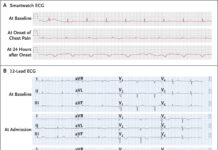
10-year-old boy with sickle-trait presented with a history of a massive ossifying fibroma involving his face and lower lip.
A 10-year-old boy presented with a 4-year history of a massive, painless and slowly growing ossifying fibroma. The boy had a known sickle-trait and was referred from the dental surgery department. The dental department performed an incision biopsy and digital subtraction angiography on the patient.
Examination showed that the mass was hard, non-tender and non-fluctuant. In addition, the mass was covered with mucosa inside the oral cavity and externally on the skin. There were no signs of paresthesia or hypoesthesia of the face or lower lip. Laboratory tests showed severe microcytic and hypochromic anaemia. Moreover, the Hb HPLC was suggestive of a sickle cell trait.
The computed tomography scan showed a large, well-defined, single expansile lesion measuring, 17×9.5×12 cm. The lesion involved the body of the mandible and on the right side the antero-inferior hemi-ramus. The teeth were seen to be displaced to the lesion’s periphery, whereas, the matrix was calcified. The thin inner cortex of the mandible was intact. There was no involvement of the temporo-mandibular joints and the maxilla. Similarly, there was no cervical adenopathy.
The CT angiography showed that the bilateral facial and lingual arteries were feeding the tumour.
Findings of the incisional biopsy were consistent with the diagnosis of ossifying fibroma
The treatment plan included a gradual dissection of the lower lip off the tumour surface circumferentially till the entire mass was reached. In addition, a gigley saw was used to divide the rami proximally to the tumour. Similarly, the remaining soft-tissue attachments were gradually dissected and the tumour was removed. In addition to this, free of the tumour mass, the inner cortex of the mandible was thinned out. Moreover, a U shaped piece of bone was removed from the inner cortex of the resected specimen and was used as a free bone graft to reconstruct the mandible.
The mandible was reconstructed using 2.0 mm high profile titanium plate (Synthes®) and free bone graft. The musculature of the tongue and mylohyoid muscles were tied around the reconstructed mandible with 2-0 proline suture, providing a normal function of the mandible and associated structures. More importantly to prevent the fall back of the tongue.
Postoperative care
The patient was intubated for 2 days to prevent asphyxia because of pharyngeal oedema and fall back of the tongue. The drain was removed on the fourth day after the procedure. Dyanplast strap was used to support the lower jaw. The patient was advised physiotherapy.
The boggy lower lip resulted in drooling of saliva. However, in 6 weeks, the oral seal was gradually achieved.
Follow-up
6 weeks after surgery, the patient could elevate and depress his lower jaw over 3.5 cm amplitude. In addition, tongue movements were normal with an adequate competency of the lips. There were no signs of resorption of the bone graft on the plain radiograph. The soft tissue started to contract and gave a more normal appearance.

Future reconstruction was planned in two stages, temporary with bone plates and free bone graft and permanent planned at the age of 18 to 20 years when the patient’s growth would seize. Moreover, the residual deformities would be corrected with better aesthetics.
References
Massive ossifying fibroma of the mandible in a child https://www.ncbi.nlm.nih.gov/pmc/articles/PMC3628239/



